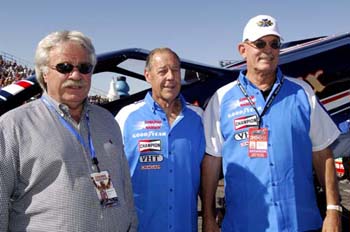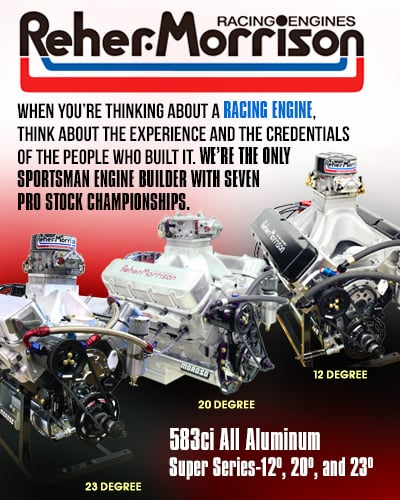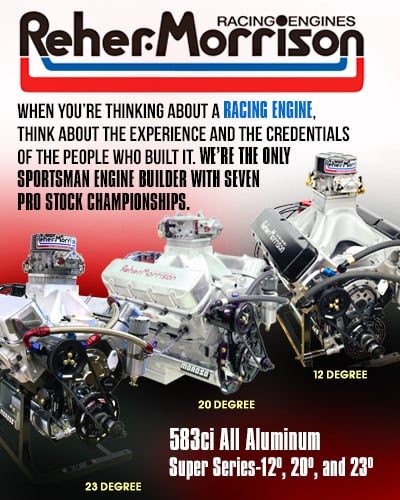ENCORE: BEADLE'S 1981 ROOF SWAP
Originally published 3-21-2009
Necessity Was A Real Mother That Day …

Ancient Greek philosopher Plato is quoted often as saying, "necessity is the mother of invention". During the 1981 NHRA

Winternationals in Pomona, Ca., necessity ran headlong into the need for invention.
Never has there been a more stunning example of a problem that encouraged creative solutions than the time Raymond Beadle had his Blue Max Funny Car leave the starting line as a hard top and return a convertible.
It wasn’t the sight of the roof ripping from the lightweight Plymouth Horizon shell that would have captured Plato’s attention. What transpired as Beadle and the crew reached the pit area might have led the philosopher to his alter his saying slightly, making it "necessity is the mother of intervention".
Beadle laughs as he remembers the day he and the team did what they had to do to make the final around against fellow Texan and championship contender Billy Meyer.
His accomplice was former junior high schoolmate Kenny Bernstein who offered up his old Plymouth Arrow body as a means of enabling Beadle to make the final round.
The Plymouth Arrow body wouldn’t have fit the chassis without massive amounts of work and with time running out before they had even made their way back to the pits, Beadle made the logical choice.
He planned to cut the roof from Bernstein’s fiberglass body and morph it onto his wounded Mopar shell.
“We didn't think anything about it at the time,” Beadle admitted, in a recent interview with CompetitionPlus.com. “Now you look back

and it sounds kinda goofy. Of course, it was the final of the biggest race and you are going to make do some way.”
Making do, in Beadle terms, has always been open to interpretation and few could have ever expected his next move.
Those who watched from outside the ropes of the Blue Max pits could only stare in utter amazement at what was transpiring.
Two partial Funny Car bodies sitting side-by-side, one a hard top and the other an impromptu convertible, in between a group of crazed individuals slinging wrenches and hurling fiberglass goop and anything else they could get their hands on.
There were some that belonged to the team and others who didn’t.
One of those who definitely belonged was Fred Miller.
Miller was a longtime crewman for the Blue Max team dating back to the Harry Schmidt days. He can’t help but shake his head when recalling the day he became much more than a crewman. He became an innovator.
“It was no different than any other situation – either way you’re thrashing your ass off to make the next run,” Miller said. “The old roof was confetti so we said, 'wait a minute, Bernstein has the same thing,' So we ran over there and Bernstein unloaded his car. We sent some guys over there with a jigsaw and they cut the roof off and brought it back over.”
 Miller said he knew prior to the fateful run that it was only a matter of time before the roof let go. There had been warning signs.
Miller said he knew prior to the fateful run that it was only a matter of time before the roof let go. There had been warning signs.
On every run the roof would cave in and Beadle would actually blast through the traps at 250 miles per hour, one hand on the wheel, the other holding the roof up. Then would come the tricky part where he would have to decide which took precedence, the steering wheel or the roof when it came time to reach for the parachute lever.
Beadle wouldn’t say which took precedence but added back in those days, a driver would just react out of instinct.
“I don't know how I managed to pull it off, we did lots of stuff back in the old days,” Beadle added. “If you looked back now you would wonder how you did it, but we survived.”
Surviving the pre-final round thrash might have been quite an accomplishment in itself according to accounts offered by Miller.

“While we're maintaining the car there was a bunch of guys fiberglassing, pop riveting, patching and this and that,” Miller recalled.
The subject was discussed by Miller in an April 2003 issue of National DRAGSTER. The Pomona thrash was voted one of its five all time thrashes, trailing only Shirl Greer’s 1974 NHRA Finals burn down.
"At first, no one thought we would have [enough] time, but we dived in anyway,” Miller told National Dragster. "We cut Bernstein's car at the bottom of the windshield pillars and put it on our car. We had a million guys patching and taping and pop-riveting on aluminum pieces. It seemed like we had at least one guy from every other team there. We gooped on some fiberglass with some hardener and heated it up and hoped for the best.”
A good sign that the patch job was meant to be was in how the roof lines matched up.
“What was really bizarre, and you can look at pictures from the starting line, it was a blue car and it had the exact same red, white and blue stripe up over the whole car and Bernstein did too and that red, white and blue stripe lined up with ours only it was a red roof and ours was a blue roof,” Miller explained. “When we pulled up to the starting line it just looked like a blue car with a red roof with a red, white and blue stripe on it.
Bernstein admitted his longtime friendship with Beadle influenced his decision to sacrifice the Plymouth Arrow body.
"Raymond and I were good friends and hung out a lot in those early days, so it was just a normal thing for me to offer it up," recalled Bernstein in the 2003 issue of National DRAGSTER. "When you get to the final, you have to do what you have to do. There wasn't a question in anyone's mind."
The final round of the event was almost as exciting, Beadle lost traction and Meyer’s engine died shy of the finish line. Beadle made a valiant effort to run Meyer down but ran out of track.
Little did Beadle know that in losing he’d be winning in the future.
That day led to an innovation in Funny Car body technology, the introduction of side windows to better stabilize the roof lines of the Funny Car bodies. Beadle proudly claimed to be the first to sport the side windows.
“A lot of this stuff, the safety features now everybody takes for granted, they have to realize we found out about this stuff the hard way and we had to fix them,” Bernstein added. “Some people don't even know why the side windows are in the car. That was just to put extra strength in the car and keep the roofs from flying off.”



































